Watch a video of our church being built
Join Deacon Bob on a Virtual Tour of St. Jude
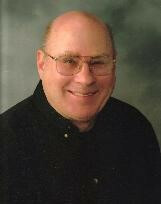 I remember the homily that Father Mike Slattery, our former pastor, gave one Pentecost Sunday. His homily was all about "church" and it concluded with the following: "If someone should ask, 'tell me, what is the church of St. Jude like?' You might be tempted to describe this lovely building. Of course, you would be wrong. This building is where the church meets to worship. The proper response, therefore is this: 'The church at St. Jude is warm, caring and gifted.' And then, as an afterthought, 'Oh yes, the building is nice too."
I remember the homily that Father Mike Slattery, our former pastor, gave one Pentecost Sunday. His homily was all about "church" and it concluded with the following: "If someone should ask, 'tell me, what is the church of St. Jude like?' You might be tempted to describe this lovely building. Of course, you would be wrong. This building is where the church meets to worship. The proper response, therefore is this: 'The church at St. Jude is warm, caring and gifted.' And then, as an afterthought, 'Oh yes, the building is nice too."
The point he was making is that although we commonly refer to the building in which we worship as "the church," the church is really made up of people, like you and I, who come together as God's family to give praise and thanks to the God who loves us so much.
We do indeed have a nice church/worship space thanks to the generosity of so many of our parishioners who made it all possible.
I'd like to invite you to join me on a tour of our parish campus, focusing on the worship space where our parish family gathers on Sundays for Mass and for so many other sacred celebrations.
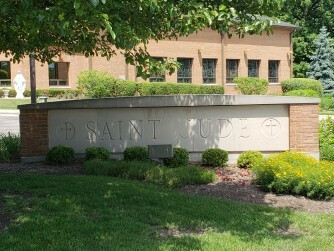 As you drive down Second Avenue and enter our parish grounds, you catch your first glimpse of our church.
As you drive down Second Avenue and enter our parish grounds, you catch your first glimpse of our church.
Notice the sign in the lower right side of the picture identifying this as Saint Jude Church. This piece of stonework was over the front entrance of the old church. It's now placed in a position of honor as a reminder to the sacrifices and generosity of past generations in building our previous places of worship.
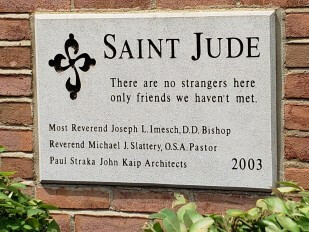 On April 3, 2003 our church was dedicated by Bishop Joseph Imesch, who celebrated the first Mass in our new church together with Fr. Mike Slattery, our pastor at the time, and many parishioners. Also present were village officials and pastors of the local Christian churches.
On April 3, 2003 our church was dedicated by Bishop Joseph Imesch, who celebrated the first Mass in our new church together with Fr. Mike Slattery, our pastor at the time, and many parishioners. Also present were village officials and pastors of the local Christian churches.
On the cornerstone, to the right of the main entrance, are the words that for many years greeted parishioners and visitors as they entered the doorway of our old church, "There are no strangers here, only friends we haven't met." We always strive to be a welcoming community - open to all who come here to find Jesus in Sacred Scripture, the Eucharist and in a loving and worshiping community.
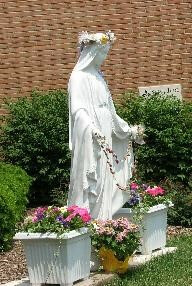 To the right of the main entrance you will find a statue of Jesus' mother Mary - our "Lady of Grace."
To the right of the main entrance you will find a statue of Jesus' mother Mary - our "Lady of Grace."
It is here, in the month of May, that the crowning of Mary takes place.
Mary has always had a special place in the Church because of her saying an unconditional "Yes" to God when she was asked to be the mother of our Lord and Savior. "Behold the handmaiden of the Lord. Be it done unto me according to thy word."
While we do not worship Mary (worship belongs only to God) Mary does have a special place of honor in the Church. Mary is truly a role model for all disciples.
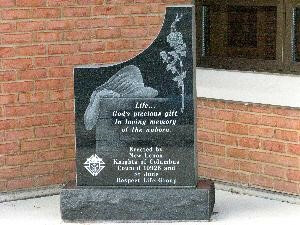 To the left of the entrance of the Church is a "Memorial to the Unborn". It is dedicated to all those unborn children who never had the chance for life because of abortions.
To the left of the entrance of the Church is a "Memorial to the Unborn". It is dedicated to all those unborn children who never had the chance for life because of abortions.
The Knights of Columbus Father Dick Allen Council 10926 erected this memorial to call our attention to the need for all people to respect life, from conception to death, as precious gift from God.
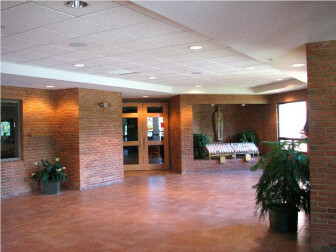 We're standing in the narthex (you might call it the vestibule) of the church. This is where members of our parish gather before and after Mass to share Christian hospitality.
We're standing in the narthex (you might call it the vestibule) of the church. This is where members of our parish gather before and after Mass to share Christian hospitality.
Members of our parish are usually there before Mass to greet you. And our priests and deacons are usually in the Narthex after Mass should you need to speak with them.
To the right, as you walk in, are the doors leading to our Day Chapel where weekday Masses are celebrated. The Day Chapel also provides extra seating for weekend Masses.
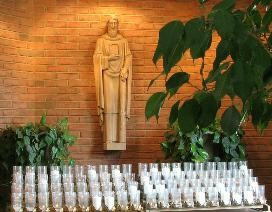 To the right of the doors is our shrine to St. Jude, the patron saint of our parish. The statue is from our old church and the candles that burn are lit as a prayer is said to our patron. St. Jude was one of the twelve apostles that Jesus chose to carry on his mission of building up the kingdom of God. St. Jude is the patron saint of the impossible.
To the right of the doors is our shrine to St. Jude, the patron saint of our parish. The statue is from our old church and the candles that burn are lit as a prayer is said to our patron. St. Jude was one of the twelve apostles that Jesus chose to carry on his mission of building up the kingdom of God. St. Jude is the patron saint of the impossible.
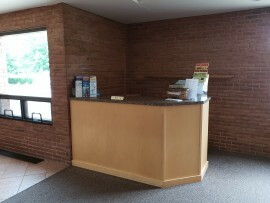
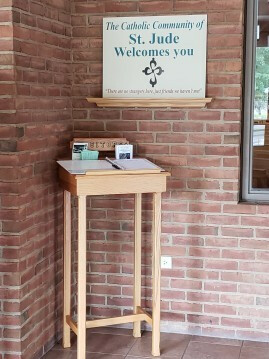
Across and to the right of the information desk is a visitor's book where visitors are invited to sign-in and leave a comment about your experience at St. Jude's.
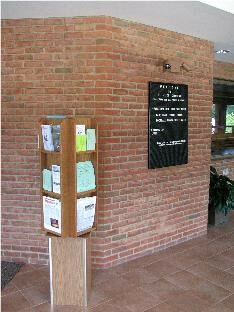 As you walk to the left you'll see an information kiosk and a sign board. The kiosk has information about various ministries and upcoming
As you walk to the left you'll see an information kiosk and a sign board. The kiosk has information about various ministries and upcoming
The narthex is also a convenient space for parents to use when the "children's room" is full or when the space in the room is too confining.
The scripture readings, prayers, and singing can be heard though the speaker system in the narthex. The narthex is also separated from the main worship space by large interior windows so that parents see and hear what is taking place during the Mass.
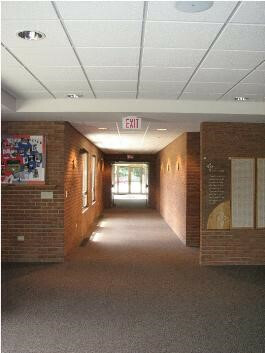
Continuing through the main narthex you enter a corridor leading to the west narthex, where you will find the men's and women's washroom, a drinking fountain, the Bride's Room, the kitchenette area and an exit to the West parking lot.
On the right is the Priest and Deacon Vesting Sacristy. This is a place for quiet and prayer to help them in their immediate preparations for ministry.
Just beyond is the Acolyte Vesting Room which is used by the altar servers and other liturgical ministers as they 'sign-in' for their ministry, vest for their ministry and look for notes about the celebration.
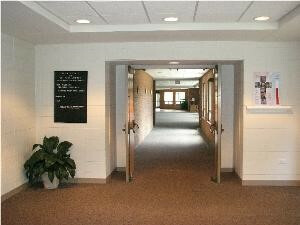 Here we are in what's called the west narthex. This is where most of our fundraising takes place.
Here we are in what's called the west narthex. This is where most of our fundraising takes place.
In addition, we have a kitchenette where we host coffee and donut Sundays and other social activities.
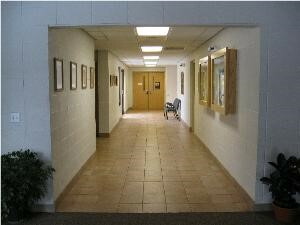
This is the corridor leading from the west narthex to the parish office. Hanging on the left-hand wall are pictures of our priests and deacons.
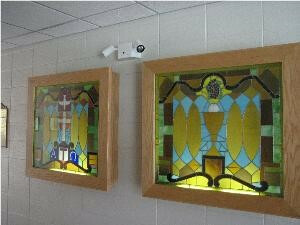 On the right-hand wall, you will see two stained glass windows. These windows were made by one of our parishioners. They were located over the two side doors to our old church. They are now back-lit so that you can see their beauty.
On the right-hand wall, you will see two stained glass windows. These windows were made by one of our parishioners. They were located over the two side doors to our old church. They are now back-lit so that you can see their beauty.
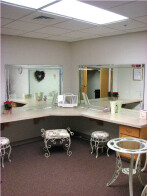 Before we leave the west narthex, I thought you might enjoy a peek into the bride's room.
Before we leave the west narthex, I thought you might enjoy a peek into the bride's room.
This room is beautifully decorated and offers the bride and her attendants a comfortable room for preparations before the wedding. It has good lighting and plenty of mirrors.
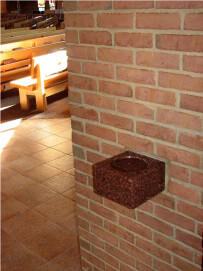 We are now entering the main worship space. This is where the church - the "People of God" (that's you and I) enter sacred space to worship, to pray and give praise and thanks to our loving God. On the side of each doorway, is a marble basin containing holy water.
We are now entering the main worship space. This is where the church - the "People of God" (that's you and I) enter sacred space to worship, to pray and give praise and thanks to our loving God. On the side of each doorway, is a marble basin containing holy water.
It is the normal practice for Catholics to dip their fingers in the holy water and make the Sign of the Cross. We do this as a reminder of our baptism (we were baptized with holy water in the Name of the Father, Son and Holy Spirit.) You can also dip your fingers into the holy water in the baptism font and then cross yourself.
We also make the sign of the cross with holy water when leaving church. This reminds us that we are called to live out our baptism commitment (to love God and one another) when we leave church to go to our homes our workplaces and our community.
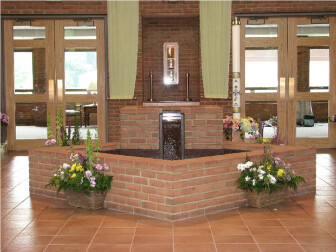 The first thing you might notice is our baptism font. In older churches, the font was located off to the side in a separate chapel, or somewhere up towards the front.
The first thing you might notice is our baptism font. In older churches, the font was located off to the side in a separate chapel, or somewhere up towards the front.
Today, it is common to find the baptism font near the entrance to the worship space. It symbolizes that Baptism is how we enter into our life as Catholic Christians. At the time of Jesus, and even now, water is a sign of life. When we are baptized we begin a whole new life as members of God's family, sons and daughters of God, brothers and sisters of Jesus Christ - we are all spiritually related.
The living water flowing from the upper to lower pool is a constant reminder of our baptism and call to Christian witness. The upper pool is used for infant baptism and the lower pool can accommodate adult baptisms. It is most appropriate to bless oneself with the water in the font each time one passes it.
 Standing next to the baptism font is the pascal candle. This is the candle that is blessed at the Easter Vigil and symbolizes the presence of the Risen Christ in our midst. The pascal candle is lit during baptisms and funerals and for the entire Easter Season.
Standing next to the baptism font is the pascal candle. This is the candle that is blessed at the Easter Vigil and symbolizes the presence of the Risen Christ in our midst. The pascal candle is lit during baptisms and funerals and for the entire Easter Season.
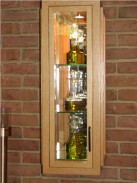 On the wall behind the baptism font is a lighted wood and glass cabinet called the ambry. This is where the Holy Oils are reserved.
On the wall behind the baptism font is a lighted wood and glass cabinet called the ambry. This is where the Holy Oils are reserved.
These oils, Sacred Chrism, Oil of the Catechumens and Oil of the Sick are consecrated and blessed every year by the Bishop during Holy Week at the Chrism Mass. They are then used at many different celebrations such as baptisms, confirmations and anointing of the sick.
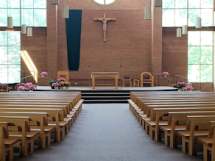 We are looking toward the altar and the sanctuary where the Eucharist (Mass) is celebrated along with the other Sacraments.
We are looking toward the altar and the sanctuary where the Eucharist (Mass) is celebrated along with the other Sacraments.
The main worship space along with the Saint Augustine Day Chapel will seat approximately 1200 people.
There is space for wheelchair and handicap seating to the right of the sanctuary (altar platform).
In addition to these seating areas we have a Children's Room. Children are important members of our parish community. This room offers to parents with young children a space in which they may begin the process of teaching the proper etiquette to be used during the celebration of Mass. This room is equipped with a restroom and changing table.
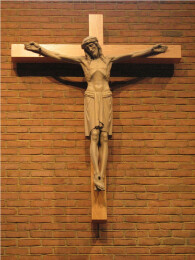 On the wall, directly behind the altar is a crucifix that was part of the old worship space. It was retained to enhance the new worship space and to make a connection between the two spaces.
On the wall, directly behind the altar is a crucifix that was part of the old worship space. It was retained to enhance the new worship space and to make a connection between the two spaces.
As the focal point of the sanctuary, the altar has a place of prominence in the church.
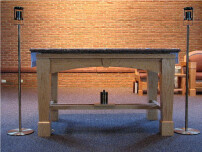 During the dedication of the new church, the altar was consecrated with Sacred Chrism by Bishop Imesch. The Bishop also placed a relic of St. Jude in the bronze reliquary beneath the altar. The granite top adds to the beauty and significance of the altar.
During the dedication of the new church, the altar was consecrated with Sacred Chrism by Bishop Imesch. The Bishop also placed a relic of St. Jude in the bronze reliquary beneath the altar. The granite top adds to the beauty and significance of the altar.
There are two chairs to the right of the altar. When leading the Assembly in prayer the priest and/or deacon are seated in these chairs which identify their role in the Assembly. These and the other appointments on the altar platform are made from solid oak wood.
To the left of the altar is the Ambo. The proclamation of the Word (readings from Sacred Scripture) takes place at the Ambo.
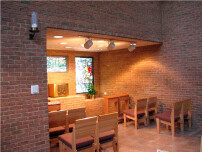 To the right of the altar platform is the Blessed Sacrament Chapel and tabernacle.
To the right of the altar platform is the Blessed Sacrament Chapel and tabernacle.
Within the Chapel the Blessed Sacrament is reserved in the tabernacle for private devotion and the reception of Holy Communion by the sick and home bound.
The tabernacle is the one that was used in the old church.
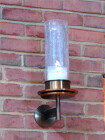 The sanctuary lamp is a lit candle on the wall to the left of the Blessed Sacrament Chapel. This candle burns continuously (except from Holy Thursday to the Easter Vigil) as a reminder that the Eucharist, our Living Christ, is truly present in the tabernacle.
The sanctuary lamp is a lit candle on the wall to the left of the Blessed Sacrament Chapel. This candle burns continuously (except from Holy Thursday to the Easter Vigil) as a reminder that the Eucharist, our Living Christ, is truly present in the tabernacle.
You are welcome to visit the church, and the Blessed Sacrament Chapel during the week for some quiet and reflective prayer time.
On the First Friday of each month, the Blessed Sacrament is exposed in the monstrance for adoration throughout the day. Adoration concludes with Benediction at 5pm.
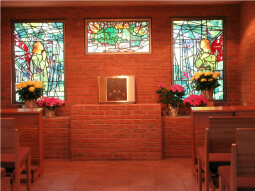 The two stained glass windows to either side of the tabernacle depict the angels that are in constant prayer before the throne of God. The window in the center depicts the burning bush where Moses encountered God on Mount Sinai and was told by God to take off his sandals because, where he stood was holy ground. It is a reminder that we too are standing on holy ground.
The two stained glass windows to either side of the tabernacle depict the angels that are in constant prayer before the throne of God. The window in the center depicts the burning bush where Moses encountered God on Mount Sinai and was told by God to take off his sandals because, where he stood was holy ground. It is a reminder that we too are standing on holy ground.
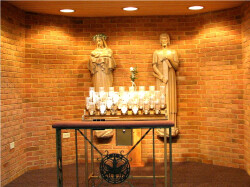 The Holy Family Shrine is a quiet and prayerful place. The statue of the Blessed Mother holding the Child Jesus, and the statue of Saint Joseph were brought over from the old worship space. Votive candles allow one's light to shine in the presence of the Holy Family, even when one may not be physically present. They are a sign of our continuing remembrance, honor and devotion in prayer.
The Holy Family Shrine is a quiet and prayerful place. The statue of the Blessed Mother holding the Child Jesus, and the statue of Saint Joseph were brought over from the old worship space. Votive candles allow one's light to shine in the presence of the Holy Family, even when one may not be physically present. They are a sign of our continuing remembrance, honor and devotion in prayer.
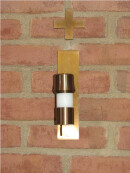 To the right is a picture of one of twelve dedication crosses and candles that are located around the inside walls of the church. At the Mass of Dedication, these crosses were anointed with Sacred Chrism to signify that this building has been dedicated to the worship of God and claimed for Christ our Savior. The candles are lit each year on the anniversary of the Church's Dedication and on other special feasts.
To the right is a picture of one of twelve dedication crosses and candles that are located around the inside walls of the church. At the Mass of Dedication, these crosses were anointed with Sacred Chrism to signify that this building has been dedicated to the worship of God and claimed for Christ our Savior. The candles are lit each year on the anniversary of the Church's Dedication and on other special feasts.
If you have some time before or after Mass, take a walk around the church to see if you can spot all twelve of these crosses.
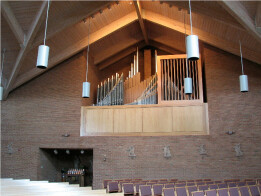 The organ from the old church was refurbished for use in the new church. The organ pipes can be seen on the west wall of the church.
The organ from the old church was refurbished for use in the new church. The organ pipes can be seen on the west wall of the church.
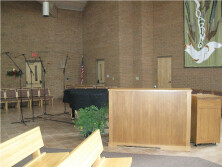
The grand piano was purchased to enhance the music.
We have two adult choirs, a children’s choir and a teen choir as well as a hand bell choir - all to help us lift our voices in song to praise and worship our loving God.
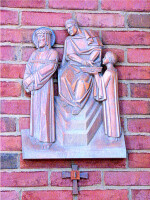 On the west wall behind the music area, you will find the beginning of the Stations of the Cross. This is the First Station - Jesus is Condemned to Death.
On the west wall behind the music area, you will find the beginning of the Stations of the Cross. This is the First Station - Jesus is Condemned to Death.
There are fourteen stations which trace the path that Jesus walked as he was led to his crucifixion and death. The plaques were brought over from the old Church.
While you may walk the stations at any time during the year, we have a communal celebration of the Stations of the Cross each Friday during Lent.
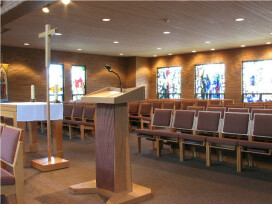 We continue our tour with a look at the Saint Augustine Day Chapel. The Day Chapel is used for the celebration of daily Mass as well as for prayer services and other gatherings where only a small number of parishioners are present. It seats approximately 200.
We continue our tour with a look at the Saint Augustine Day Chapel. The Day Chapel is used for the celebration of daily Mass as well as for prayer services and other gatherings where only a small number of parishioners are present. It seats approximately 200.
It is equipped with an altar, ambo and presiders chair for use when daily Mass is celebrated. At other times, the Day Chapel provides additional seating during weekend Masses. The Saint Augustine Day Chapel's beauty is enhanced by seven stained glass windows.
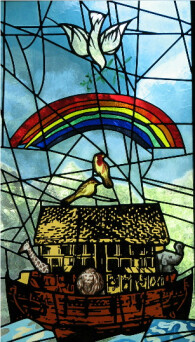 The window to the left tells the story of Noah and the ark. God rewarded Noah and his family's faithfulness by saving them from the flood. As a sign of the covenant between God and Noah and every living creature, God placed a rainbow in the sky as a sign that "the waters shall never again become a flood to destroy all mortal beings.
The window to the left tells the story of Noah and the ark. God rewarded Noah and his family's faithfulness by saving them from the flood. As a sign of the covenant between God and Noah and every living creature, God placed a rainbow in the sky as a sign that "the waters shall never again become a flood to destroy all mortal beings.
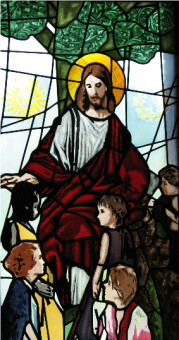 The window to the right tells the story of Jesus blessing the children. This story must have really touched the hearts of the early Christians because it is mentioned in Mark 10:13; Matthew 19:13 and Luke 18:15.
The window to the right tells the story of Jesus blessing the children. This story must have really touched the hearts of the early Christians because it is mentioned in Mark 10:13; Matthew 19:13 and Luke 18:15.
The following windows are on the East wall of the church. I'll be starting from the left as you face the windows.
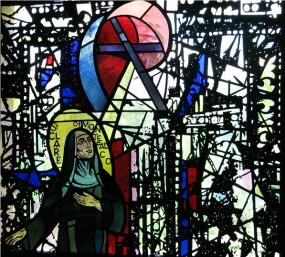 Saint Clare of Montefalco Saint Clare of Montefalco
Saint Clare of Montefalco Saint Clare of Montefalco
Augustinian Nun
1268-1308
Born in Montefalco Italy. As a teenager she was drawn to a life of prayer. She and her sister Joan founded a monastery of Augustinian nuns. A woman of great holiness: priest, theologians, bishops, lay people and jurists sought out her advice. she meditated on the sufferings of Christ and was generous to all.
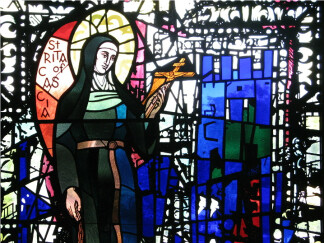 Saint Rita of Cascia
Saint Rita of Cascia
Augustinian Nun
1381-1457
Born in Roccaporena Italy. Wife, mother, widow and then religious, she is the patroness of impossible causes and was renowned as a peacemaker. Devout and filled with patience despite the infirmities she suffered in old age she was an example to the other sisters.
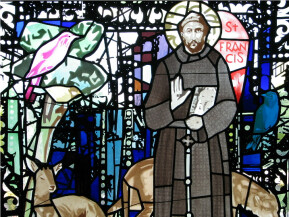 Saint Francis of Assisi
Saint Francis of Assisi
1181-1226
One of the best known and loved of all the saints. Francis founded the Franciscan Order in 1209. A man of exceptional spiritual insight, Francis identified with Christ's suffering and his words and deeds were tangible expressions of his love for God and all creation. This window is a tribute to the priests of the Franciscan Order who founded our parish in 1934.
 Saint Thomas of Villanova
Saint Thomas of Villanova
Augustinian Bishop
1486-1555
Born in Villanova Spain he was a renowned preacher and a model bishop. He was a model of simplicity of life amidst the wealth and trappings of other bishops. He was outstanding in his devotion to the poor and was known as the "Beggar Bishop."
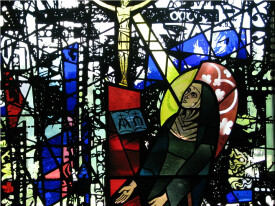 Blessed Magdalene Albrici
Blessed Magdalene Albrici
Augustinian Nun
1415-1593
Born in Como Italy she entered the Augustinian convent at 20. Renowned for her holiness she established numerous Augustinian communities throughout the region. She was dedicated to the care of the sick and needy.
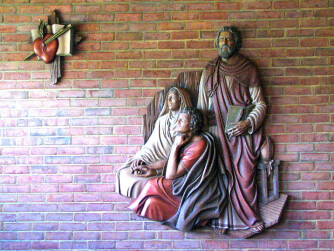 On the side wall of the Day Chapel is a slightly unusual piece of Augustinian art work.
On the side wall of the Day Chapel is a slightly unusual piece of Augustinian art work.
In the upper left-hand corner is the emblem of the Augustinian order. Pictured on the right are one woman and two men. The woman is Saint Monica, the mother of Saint Augustine. And as for the two men - they are not two different men - the one sitting down is a portrayal of Saint Augustine as young man and the man standing up is Saint Augustine when he was older and had converted to Christianity.
Augustine is probably best known for the contrast between his dedication to Christianity in his later years and his earlier self-indulgence, summed up in his prayer: "Give me chastity and continence - but not yet."
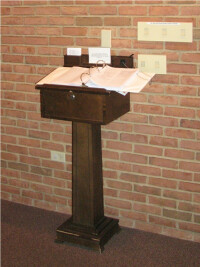 In the Day Chapel is where you will find the Mass Book for Prayer Intentions.
In the Day Chapel is where you will find the Mass Book for Prayer Intentions.
So often we have need for prayer and find strength and comfort when others are praying along with us for our needs.
You might have noticed at Mass, when the deacon or lector reads the intercessions, there is one in which the gathered church prays for our personal needs and "those written in our Mass Book."
Anytime the church is open you are invited to stop in and pray, and if you are moved to do so, write your prayer needs in the book.
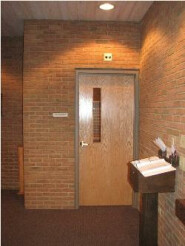 Adjacent to the Day Chapel is our Reconciliation Chapel where the Sacrament of Reconciliation is celebrated. You may refer to it as "confession".
Adjacent to the Day Chapel is our Reconciliation Chapel where the Sacrament of Reconciliation is celebrated. You may refer to it as "confession".
It is vastly different from the "confess Screened Panel for Privacyionals" that existed in older churches.
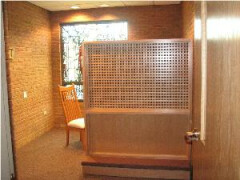
The chapel is equipped with a screened panel for privacy - if you prefer to receive the sacrament that way.
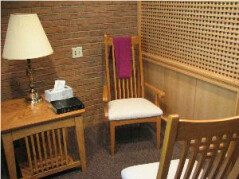
For those who might wish to celebrate the sacrament face-to-face there are chairs for both you and the priest.
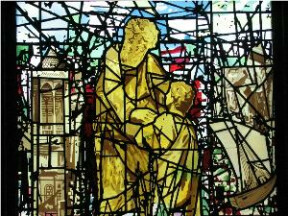 Within the chapel is a stained-glass window depicting the return of the Prodigal Son.
Within the chapel is a stained-glass window depicting the return of the Prodigal Son.
If you ever want to deepen your understanding of God's mercy and unconditional love for us, even when we have sinned against him, read the story of the Prodigal Son in Luke's Gospel, Chapter 15, verses 11-31.
Thank you for taking the time to join me on this tour.
Always remember that the church not a building. It's people like you and I - all of us, sons and daughters of God, worshiping together, praying together, caring for one another’s needs, growing together in faith.
It is so wonderful that we have a beautiful worship space in which we can gather to celebrate God's love for us and to offer him praise and thanks.
Peace be with you!
Deacon Bob
